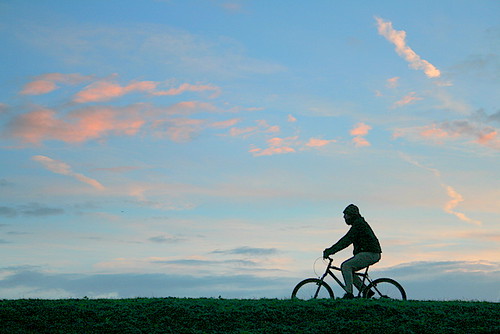 The day dawned slowly, calm and bright after the previous day's gales. I checked out the beach for any recent arrivals, and found just one Stonechat (the male) and a Rock Pipit showing themselves at that early hour.
The day dawned slowly, calm and bright after the previous day's gales. I checked out the beach for any recent arrivals, and found just one Stonechat (the male) and a Rock Pipit showing themselves at that early hour.Over the sea was a movement of auks (a word which means "I don't know if they were Guillemots or Razorbills") totalling about 300 per hour, singly and in parties of up to a dozen or so; a handful of Red-Throated Divers and two Diver sp. (a phrase which means "I couldn't tell whether they were Black-Throated or Great Northern, but they probably weren't Red-Throated").
 The picture above is not mine (nor even of me) but by a local photographer, Conundrum 37, this morning.
The picture above is not mine (nor even of me) but by a local photographer, Conundrum 37, this morning. Later, I had a stroll around Ramsgate harbour looking for anything that might have sought shelter from the wind. There was nothing apart from the usual gulls and the two Shags, one actively (and successfully) fishing around the yachts.
Later, I had a stroll around Ramsgate harbour looking for anything that might have sought shelter from the wind. There was nothing apart from the usual gulls and the two Shags, one actively (and successfully) fishing around the yachts.

Yesterday a report was issued, saying that 17% of the British coast is threatened by erosion. We've known this for centuries (well, possibly not the actual percentage, but in principle - just ask the inhabitants of the Suffolk coast), but of course 'global warming' is making the problem worse, and faster.
The report also says
climate change is already causing warmer, saltier and more acidic seas with a greater incidence of severe winds and bigger waves.
Warmer conditions can disrupt the marine food chain from top to bottom with the movement or disappearance of plankton impacting on predators such as fish which in turn affects the sea birds.
It is already known that warmer winters are linked to reduced breeding success and survival in some sea bird populations.
Yesterday's winds reached 63mph at Deal pier, with waves up to 2½m high - Fairlight in Sussex was the windiest apparently, up to 87 mph.
No comments:
Post a Comment